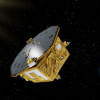Evidence of ancient tsunamis on Mars

Scientists think they see evidence of two huge tsunamis having once swept across the surface of Mars.
They point to satellite data suggesting a major redistribution of sediments over a large region at the edge of the Red Planet's northern lowlands.
The US-led team argues that asteroid or comet strikes into an ocean of water could have triggered the giant waves.
Such events could only have occurred more than three billion years ago when the planet was wetter and warmer.
Today, Mars is dry and very cold, and any impact would merely dig out a dusty hole.
But researchers have long speculated that the low, flat terrain in Mars' northern hemisphere could have hosted an ocean if the climate conditions were just right.
The nagging doubt with this theory has been the absence of an identifiable shoreline - something the new study could now help explain.

If tsunamis regularly inundated the "land", dumping sediments and scouring new flow channels, they could over time have disguised what otherwise would have been an obvious "coast".
"Clearly, it's one of the implications of this work: to have tsunamis, you must have an ocean," said Alexis Palmero Rodriguez from the Planetary Science Institute in Tuscon, Arizona.
"So, we think this is going to remove a lot of the uncertainty that surrounds the ocean hypothesis. Features that have in the past been interpreted as relating to an ocean have been controversial; they can be explained by several, alternative processes. But the features we are describing - such as up-slope flows including large boulders - can only be explained in terms of tsunami waves," he told BBC News.
Dr Rodriguez and colleagues' tsunami findings appeared on Thursday in the journal Scientific Reports. Their work centres on two connected regions of Mars, known as Chryse Planitia and Arabia Terra.
The team claims that the sediments observed by satellite betray the action of two ancient mega-tsunamis.

The older event is perhaps easier to understand in an Earth context, where energetic waves can pick up sediments, including massive boulders, and dump them at a higher elevation. The water, as it turns back to run downhill, then cuts new channels - such as the ones identified on Mars by Dr Rodriguez's group.
But the scientists go on to describe the traces of a second, younger event. This is calculated to have occurred a few million years later, when the climate had cooled significantly. In this instance, the tsunami wave likely froze as it propagated across the land surface. This is suggested by the observation of "lobes" of sediment without the backwash channels.
On Earth, the frozen floes capping a sea or a lake can sometimes be pushed ashore by a storm surge. It is an unusual phenomenon but would be analogous to what is being suggested - albeit on a much larger scale - for Mars.
The team has estimated the energetics of the impacts and their ensuing tsunamis, based on the scale of the sediment distributions.
The craters that were produced were probably about 30km across, they say. The waves could have been 50m in height, or even 120m at some locations.
The areas affected by the tsunamis cover some 800,000 sq km for the older event and 1,000,000 sq km for the younger one.
"On Earth, the K-T boundary impact (that wiped out the dinosaurs) produced an enormous tsunami wave that hit the continental United States, equivalent to the area we see flooded in our study region on Mars," Dr Rodriguez added.
Wet Red Planet?
Having lost some currency, the idea of an ocean on Mars is gaining popularity again.
Investigations by Nasa's Curiosity rover at Gale Crater have revealed that the deep bowl likely contained persistent lakes in the past.
Such water, it is argued, could only have been maintained if there was a robust hydrological system on Mars, cycling moisture between a large sea somewhere on the planet, its atmosphere and its land surface.

"[The] large expanse of currently documented tsunami inundation is but a portion of what occurred along the margin of the Martian northern plains-filling ocean," said co-author Kenneth Tanaka of the US Geological Survey.
"Tsunami-related features along other parts of the ocean margin, and potentially other smaller former bodies of water, remain to be identified, mapped and studied in detail."
Peter Grindrod from University College London was not involved in the study. He commented: "The idea of a northern ocean on Mars has been floating around for decades. But the evidence hasn't been able to push this idea forward as the consensus view.
"However, this possible evidence of tsunami deposits is interesting and, along with other recent studies of widespread deltas, could perhaps mark the beginning of a reinvigoration of the ocean hypothesis."

The lobe deposits from the younger event would be an excellent location for future exploration by surface robots or astronauts, the team believes. They are relatively undisturbed and so probably retain important information about the nature of the ocean, and possibly even some bio-signatures if the body of water happened to support life.

 For all latest news, follow The Daily Star's Google News channel.
For all latest news, follow The Daily Star's Google News channel. 








Comments